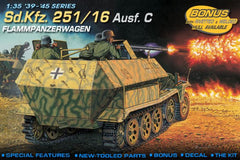Features:
- Brand new one-piece 40cm DS tracks
- 2cm Flakvierling 38 cannon w/accurate detail
- Gun cradle offers great detail definition
- Gun sight and hand wheels w/well-defined detail
- Spent-shell cage made from photo-etched part
- Slide-molded one-piece gun barrel w/hollow muzzle
- Gun-sight cover can be assembled open/closed
- Cannon can be freely posed at different angles
- 2-directional slide-molded turret for Wirbelwind w/realistic weld seams
- Scale-thickness fighting compartment armor has extra-thin top edge
- Ammo magazines inside turret w/great detail
- Turret ring accurately produced
- Gun mounting platform realistically produced
- One-piece lower hull made from slide molds
- Hull bottom has full and correct details
- Side fenders w/pattern detail on both top and bottom surfaces
- Injection-molded fenders made to thinnest possible dimensions
- Final drive housing w/details on both sides
- Separate armored cover for final drive housing
- Sprocket wheels w/breathtaking detail and multiple delicate parts
- Road wheels and suspension exhibit extreme details
- Idler wheels w/correctly detailed parts
- Injection-molded on-vehicle tools w/clasps
With Allied aircraft increasingly dominating the skies over Europe as WWII progressed, there was a need for more effective self-propelled antiaircraft guns for German forces. One solution was the Flakpanzer IV, a vehicle nicknamed Wirbelwind, or "Whirlwind" by the Germans. Development commenced in 1944 as a brainchild of Karl Wilhelm Krause, and the vehicle featured a quadruple 2cm Flakvierling 38 weapon system mounted inside a nine-sided turret. The turret was open-topped to allow fumes generated from the four cannons to dissipate. As can be imagined, the Wirbelwind was a quick-firing weapon, and it could also be employed against ground targets. A crew of five operated it. Approximately 100 of these 22-tonne weapons were produced on rebuilt or repaired Panzer IV tank chassis.













